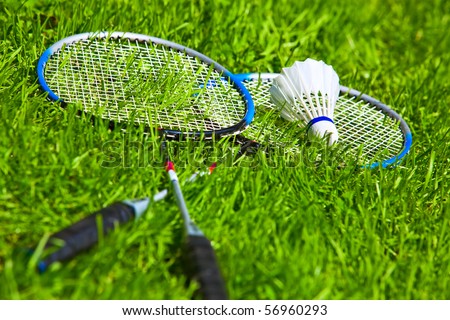How would you mathematically clarify the important elements required to succeed in world sports, particularly badminton?

Answer:
Skill+ 2(strength)+ resolution+ practise= Prerequisites for any sport
Endurance+ agility+ confidence+ good control= Necessities for badminton
Optional: Interest in sociology of sports
It turns out that yet another component plays an influential factor in a game like badminton—a person’s gender.
Badminton, one of the 8000 varied sports in the world, shares the common feature of being an inherently male dominated sport. As of 2004, the number of male badminton players (in the 16-34 age-group) was almost double the number of their female counterparts (retrieved from sports.espn.go).
Originally traced back to 16th Century Japan and Greece, badminton as we know today, was a 300-year-old European innovation in India. Then, elite men and women somberly playing shuttlecock and battledore were a very common sight.

Over the years though, the formula has changed dramatically as restrictions in movement have completely vanished.
Present day badminton= verve+ vitality+vivacity [B= 3V]
There is a certain degree of ease for those with a strong and supple body that is fairly well-built and amply energized. Men naturally have an upper hand in such a fast racquet sport that requires continuous exertion.
Here is how these gendered processes related to sports can be justified by hegemonic masculinity:
To summarize (and, once more, grossly to simplify) such positions, sport is a crucial site for the reproduction of patriarchal structures and values, a male- dominated secular religion that has celebrated the physically aggressive and often violent deeds of men. Sport has been an integral element of self- sustaining forms of exclusivist male culture, lubricating a closed system of male bonding and female denigration. (Rowe, 1998)

The last game of badminton I played was at EC, barely a few hours ago, and I must say I still feel dizzyingly tired. In the 45 minutes I spent at the game, I left the court four times to get a drink of water, and spent a total of about 15 minutes being an "audience," simply because I was too tired to play. Which brings me to the next formula:
Energy Level= Exhaustion- (Spirit + Motivation)

Towards the end of the game, my right hand ached as if it were bloated. Physical discomfort aside, I couldn't help but notice that throughout the entire span of the game, a majority of the shots were
a) exceedingly fast-paced;
b) usually directed upwards (because of the amount of strength expended on each shot, the shuttlecock would sometimes reach the ceiling, which was several feet high).
Every five seconds in a game of badminton, you are guaranteed to be doing either one of the following: jumping, running, skidding, stretching, hitting-as-hard-as-you-possibly-can. (And occasionally saying “Dayyum!” when you miss a shot because you are too distracted by the lights overhead, but that is an altogether different matter). Badminton is a reaction sport that can drain energy levels very easily, so sufficient physical strength is a must to stay buoyant.

That established, the following statistic is not particularly surprising:
Total number of badminton players in Rec Center on 18/04/’12
= 13
= 12 Males + 1 Female
Yes, I was the only female.
There are usually an equal number of women around though, said my badminton partner, Kee Guan NG. Although he agreed that such a sport involves intense physical activity, he stressed that the you-should-constantly-be-on-your-toes part of the game has not lugged back women in any way, at least in his home country, Malaysia. I learned that badminton is Malaysia’s national game and that the world’s leading player, as of 2012, is a Malaysian Lee Chong Wei.

Kee, a regular player at the Recreation Centre, continued about the relatively negligible gender segregation and equal woman proactivity in badminton, even in EC.
But I noticed that while he mentioned Wei as being the foremost international competitor, Guan said nothing about a similarly top-ranked woman player.
Which can be explained by the fact that badminton definitely has a manlike connotation attached to it. Wikipedia-- one of the most frequented websites around the world-- is proof enough of this: of the six coloured pictures of badminton players, only one shows (and rather vaguely) a woman player.
But it’s not just badminton.
For most of us, the term “Woman’s sports” is fed into our mental lexicon, while the term “Men’s sports” sounds deviously wrong.
Imagine, for example, Men’s cricket, or Men’s hockey. Or Men’s badminton. Somehow, the former part is taken for granted-- if it is a game, it is assumedly men’s.
Another interesting trend I noticed was that most players played for points
i.e. Men playing a game ∞ Level of competition

Throughout, the intense games were heavily peppered with split-second conversations like:
“What is the score?”
“Six to Seven.”
The competitiveness was amusing. Interestingly though, my game with Kee was a score-free, casual one-- the only competition-bereft game he played. Perhaps this can be explained as follows (retrieved from jsssagepub.com):
The competitive hierarchy of athletic careers encouraged the development of masculine identities based on very narrow definitions of public success. The fact that winning was pre- mised on physical power, strength, discipline, and willingness to take, ignore, or deaden pain inclined men to experience their own bodies as machines, as in- struments of power and domination—and to see other peoples’ bodies as objects of their power and domination.
Men, masculinity, speed, competition, women, socialization, badminton.
The math is really simple.
No comments:
Post a Comment
Note: Only a member of this blog may post a comment.